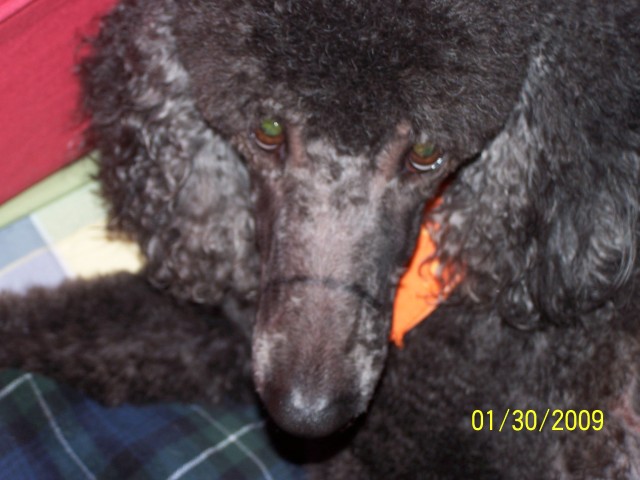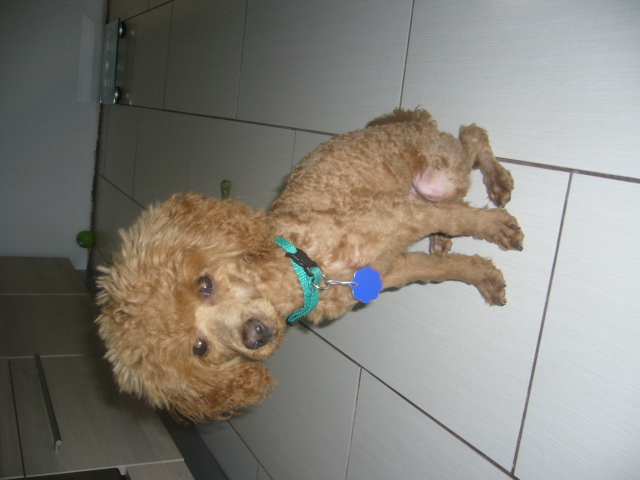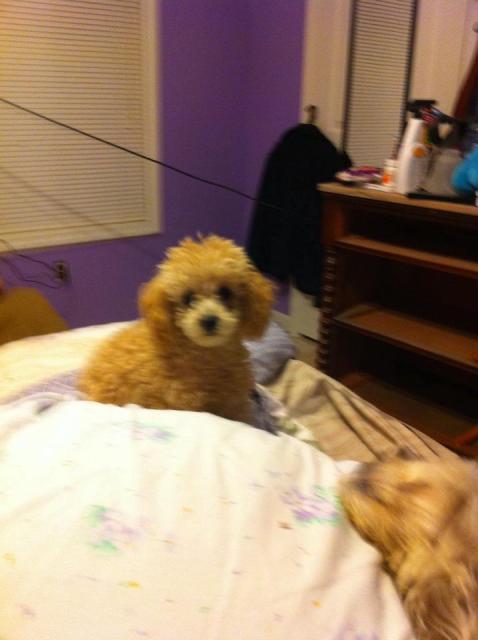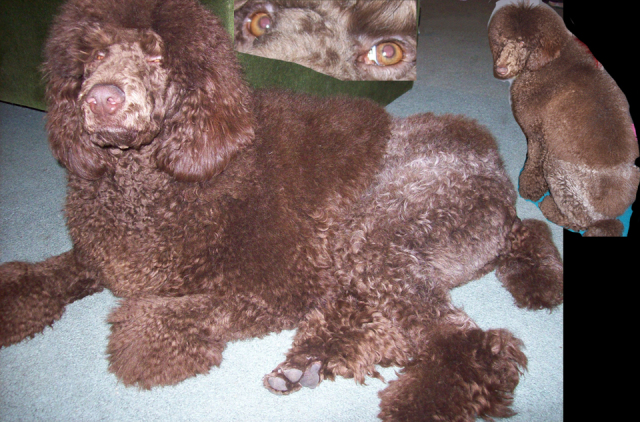Question-------------------------
Followup To
Question -
Hello,
Our 9-month-old neutered male Standard Poodle puppy is
pretty good
Dear Labman,
Thank you for answering my questions. I've heard of the mousetrap
technique and also using
balloons, but haven't tried them yet. I've kept other dogs out of trouble
by keeping them
tethered to me with a leash, but this one chews on the leash. I may try
a chain.
I wanted to let you know that we do crate all three of our dogs when
we're not home, and as you
say, they get along fine in there. We are big advocates of crate-
training. The two little dogs also
spend the night in their crates because they're not as reliably
housetrained as the poodle. They
even put themselves to bed when it starts getting late. But I'm at home
during the day and they
usually aren't left alone anyway. I also use the crate when one of them
needs a time-out from the
others.
The stealing of dishtowels, socks, etc., happens almost right before my
eyes. The poodle will
quickly grab something and prance out of the room with it. When I
hear the prancing or see it
out of the corner of my eye, I know he has grabbed something he
shouldn't have because he
never does this with his own toys. He's very ingenious about finding
things that I thought were
put away. I am worried about the intestinal blockage you mention.
When we picked him up at the
breeder's, I noticed that only one of the 12 poodles there had on a
collar. The breeder told me
that he (the one with the collar) had chewed the collars off of the other
11. So maybe it runs in
the family.
Believe me, we do not consider ourselves poodle experts! I appreciate
your advice and the time
you've taken on our questions. Thanks again.
Anne
-- sweet, beautiful, and crate- and housetrained. He
learns fast the things he wants to learn. But he steals, chews,
and sometimes swallows anything he can get into his mouth. I
say NO! and give him an acceptable chew toy but it doesn't make
a difference to him, he just looks at me. Last night I found a
thick electrical cord chewed to bits on the floor next to where he
was peacefully sleeping by our bed. Fortunately he had pulled
the plug before chewing it up. He has plenty of chew toys, he is
seldom left alone, and we take him for 2-3 walks and to the dog
park every day. By the way, he is a "secondhand dog" and we
have older dogs who don't want to play with him. He is our first
Poodle. What are we doing wrong? Thank you.
Answer -
Some dogs are chewers, bad chewers. Apparently your older dogs
weren't. Even most of the
worst chewers mellow by 3-4 years old.
A mousetrap is very effective in making a dog leave something alone.
Most
dogs will stay away from anywhere they were surprised by a snap. The
best
part is that it is not you that is correcting the dog. It works whether
you
are around or not. The mousetrap is very patient and is always on task
as
long as you reset it.
Better than mousetraps when you aren't around is the crate. Other
dogs may
not be as bad as the young Labs I am plagued with. Still your house
and dog
will be much safer with the dog in a crate when you are away. The dog
may be
happier in its den than loose in the house. It relaxes, it feels safe in its
den. It rests, the body slows down reducing the need for water and
relieving
its self. Dogs that have been crated all along do very well. Many of
them
will rest in their crates even when the door is open. I think the plastic
ones give the dog more of a safe, enclosed den feeling. They are
harder for
dogs to open too.
There are some people who have had a number of dogs like your older
ones that fancy
themselves dog experts and are quite critical of crates. I have been
reported to PETA over the
mousetraps. Of the 13 Labs I have had, I can't imagine leaving any of
them loose in the house
alone. The Shepherd and the Lab/Golden cross I have now were almost
as bad the first few
months. It is not a matter of lacking training ability. I have learned my
methods from the highly
experienced professionals at a dog guide school.
What you need to do is crate him when you can't watch him, keep a
close eye on him, correcting
him as you have been. Sometimes you may want to use a tie down. I
have a short chain with a
snap fastened to our one computer desk. I can keep the puppy there
rather than in the crate
when I am working there.
Not only are the chewers destructive, they can choke or have intestinal
blockages from the
shreds. You already had an electrical cord scare. Of course, my
friend's Lab puppy chewed up a
cord when left in the crate. She came home and found him chewing a
plug. There was a cord
running along the wall behind the crate. He managed to pull it into the
crate and ate all but the
plug.
AnswerI have gone through most of their first year with 15 different dogs, mostly Labs, plus visitors staying as long as 2 weeks. The nice thing about visitors is that with 2 young dogs, they spend most of their time chewing on each other or play fighting over things. They are too busy to get into forbidden objects. They did break a window once.
Each dog has been different. Taffy would snatch a pillow off the sofa, and lay with her head on it until you came in the room, then jump up and shake it to death. Nugget would nip at mouse traps until he set it off, and then prance off with it. He chewed up one. He also barked at them. When I heard suspicious sounds from the crate, I would check, and Lucky would have something he snatched from the table and carried off to his lair. He was an expert at taking something without disturbing the nearby mousetrap. I once tied a cracker to the mousetrap with a string. He was very upset and didn't touch the cracker again although I left it out several days. Peggy would carefully dump the plant and dirt out on the living room rug, before chewing up the plastic pot. Some dogs are much more difficult than others. Maintaining your patience when you have corrected the dog for the same thing 10 times in 10 minutes is difficult.
I like to use as gentle corrections as I can and only where I can't get by
with praise. I start with a stern "Bad dog!" or a light snap on the leash.
Often making eye contact, and staring them down is effective. It is a good way of reminding them, you are top dog. In stubborn cases, I repeat the "Bad dog!" right in its face with the dog on its back. Hold it down until it lifts one back leg to show submission.
If you are able, when it misbehaves, throw it on its back, and growl "Bad
dog!" right in its face. Hold it down until it lifts one back leg to show
submission. You may need forearm across the windpipe to control the dog. If
you can't do that, try the squirt bottle. Fill it with water and a little
vinegar or lemon juice. Give it a squirt in the face as soon as it
misbehaves. Dogs hate that. So do I, but it is very effective. Prince was a royal pain. He would snatch stuff off the table and then draw me into chasing him around it, a game I lose. One day I grabbed what I thought was a spray bottle of plain water and squirted him right in the face. I had grabbed a bottle of flea spray instead. After that, all I had to do was reach for bottle, and he dropped whatever he had.
Much of this behavior is a bid for attention. They know when they have snatched something, you will react. The difficult part is, that like some children, punishment is better than inattention. Some dogs require more than others. A lady in the group I meet with monthly had a puppy that never took a nap except when she shut him in the crate. He had a brother that was difficult too. Hang in there. In a few years, he will settle down, and you will remember all the funny things he did as a puppy. Take a break, and go to http://www.jagerslatijn.nl/jagerslatijn/poodle.htm.

 Stripe on nose
QuestionStripe on Perrys nose
QUESTION: Hello Ki
Stripe on nose
QuestionStripe on Perrys nose
QUESTION: Hello Ki
 Chocolate Standard Poodle going grey
QuestionI have a 7 month old chocolate Standard Poodle
Chocolate Standard Poodle going grey
QuestionI have a 7 month old chocolate Standard Poodle
 toy poodle hair cut
QuestionQUESTION: Hello Kim
My toy poodle Tommy is now
toy poodle hair cut
QuestionQUESTION: Hello Kim
My toy poodle Tommy is now
 hey kim! my pups are grown but i have a ?
Questionrascal
QUESTION: Hey kim, my puppies ha
hey kim! my pups are grown but i have a ?
Questionrascal
QUESTION: Hey kim, my puppies ha
 baldspot/color
QuestionQUESTION: I have a female spayed 8 month old br
baldspot/color
QuestionQUESTION: I have a female spayed 8 month old br